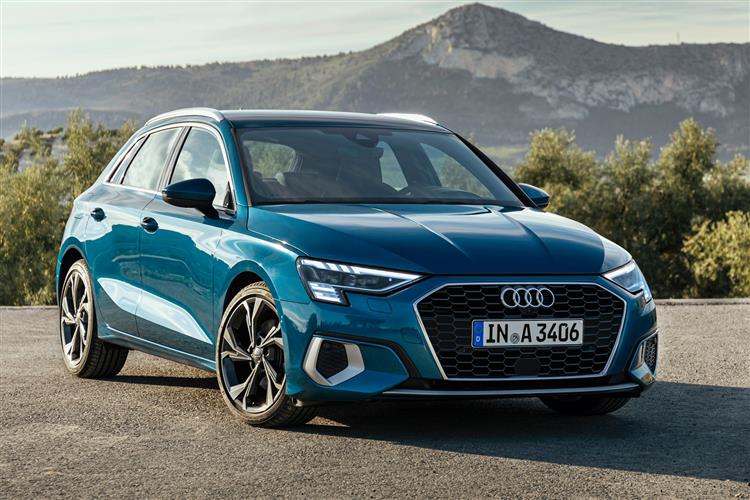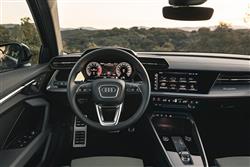THREE STYLING (some text hidden) --NONE--
By Jonathan Crouch
Introductionword count: 112
The premium compact car. If that concept means anything to you, then it's the car we look at here, Audi's A3 Sportback, that might well come to mind. Back in 2020 in MK4 form, true to the brand's Vorsprung durch Technik philosophy, this model once again aimed to set fresh standards, incorporating a completely digitalised interior and cutting-edge infotainment, plus more unique light signatures, powerful engines and a suite of innovative assistance systems enveloped in a completely redesigned, yet immediately recognisable body. The result was a car that showed just how far things had progressed in this segment. So how does this pre-facelift MK4 A3 Sportback stack up as a used buy?
Modelsword count: 23
5dr Family Hatchback (1.0 TFSI petrol / 1.5 TFSI petrol / 2.0 TFSI / 2.0 TDI) [Technik,Sport, S line, Vorsprung, S3, RS 3])
Historyword count: 550
The Audi A3. It's a posh hatchback isn't it? Well yes, but it's also much more than that. It was the car that really established the premium compact class way back in 1996. By 2020, over 5 million sales on, this MK4 model aimed to re-define this segment once again, primarily with this Sportback hatch body style. A quarter of a century ago when we first saw the A3 model line in its original 'Typ 8L' form, the idea of being able to move a car up-market in class and appeal without increasing its size was new and rather different. Cynics dismissed it as a way of dressing up ordinary family hatches and charging a lot more for them. Customers though, loved the idea and by the time the second generation 'Typ 8P'-series A3 arrived in 2003, BMW and Mercedes rivals had also arrived to swell the market. Initially, those two brands struggled to produce products good enough to overtake Audi and the result was that nearly a quarter of a million MK2 A3s were pounding global roads by the time the third generation 'Typ 8V' model arrived in the Autumn of 2012. It sold for nearly eight years, with a useful update in 2016, until this more cutting-edge 'Typ 8Y' MK4 model arrived in early 2020. All of these designs were based on shared VW Group engineering. And shared parentage can be both a blessing and a curse. Certainly, it was an enormous advantage that this fourth generation car was founded almost entirely on what is generally recognised as the market's most thoroughly engineered and best quality volume brand family hatch, the eighth generation Volkswagen Golf. But the downside from Audi's point of view was that the same engineering, complete with evolved MQB platform, was also used by the latest versions of SEAT's Leon and Skoda's Octavia which, predictably, were thousands of pounds cheaper. So why pay the extra, new or used, for Ingolstadt's idea of what a cutting-edge compact family hatch should be? Well, there are plenty of reasons why you might. Premium brand interpretations of any product don't tend to deliver anything fundamentally different from more affordable versions of the same thing. They just package it all in a more appealing way - which has been the secret of this model line's success and is the reason why by 2020, over 600,000 A3s pounded our country's roads. Most of them featured this five-door hatch body style, which had been known to A3 buyers as a 'Sportback' ever since 2004. By 2020, it no longer sold alongside a three-door hatch variant (which was a disappointment as that meant we didn't get another A3 Cabriolet), but there was a sharp-suited Saloon version for those who wanted an alternative and, of course, the usual hot hatch derivatives. Whatever your choice of A3 body shape, you can expect it all embellished with the plushest, best connected and highest quality cabin the segment had to offer from this period - plus across the range, there was a full portfolio of cutting-edge engine tech, including both mild hybrid and plug-in powertrain options. This MK4 A3 Sportback sold in its original form until the beginning of 2024, when it received a facelift. It's the pre-facelift 2020-2023 versions of this model we look at here.
What You Getword count: 485
Audi talks of the way that this fourth generation A3's styling had been 'revolutionised', something that designer Immo Redeker was very enthusiastic about. The MK4 range was primarily based around the five-door Sportback body shape - the only other option was a saloon - which was given a more athletic stance and a slight size increase. Inside up-front, there was a more immersive style of ergonomic design for this fourth generation model - in the way the air vents combined with the instrument binnacle and the manner in which the centre screen and the re-designed climate controls just below were canted towards the driver. Much effort went in to visually emphasise the width and spaciousness of this cabin, most notably with precise horizontal lines and surfaces. Not all of it was smoke and mirrors; the seats were set a little lower to improve headroom, plus there was slightly more shoulder room too. And you're going to really like the quality and classy design on show here - things like the hexagonal contrasting stitching on the dash top and the striking line of vents on the passenger side, with a smart curved trim strip below. Earlier, we mentioned the screens; here, they represent what Audi called a 'new level' of digital technology, the 10.25-inch Virtual Cockpit instrument binnacle display standardised and working in concert with the 10.1-inch 'MMI Navigation plus' centre stack monitor. This central screen was based on an 'MIB 3' modular infotainment platform that offered ten times the computing power of the previous set-up and had a vastly improved intuitive voice control system. Plus this MMI system was permanently connected to the internet, with high speed access via an embedded eSIM, which means you can create in the car a WiFi hotspot and access things like online music streaming, online traffic information and hybrid radio. As with most cars in this segment, it's not particularly spacious in the back. You'd certainly love to find the kind of sliding, reclining bench you can have in a comparable Audi Q3 SUV - but that sort of thing doesn't tend to feature on a conventional hatch. A six-footer can sit behind an equally lanky driver, but it's a fairly snug fit and, as you'd expect from this class of car, three across the back here only really works if the people concerned are of school-going age. The high centre transmission tunnel certainly doesn't help in that regard. Finally, let's consider the boot, 380-litres in size as it was before. If you need room for longer items, you'd better have avoided base 'Tecknik' trim because it's only above that level that you get the 40:20:40-split rear backrest, the centre part of which can be pushed forward between a couple of rear-seated passengers for the easy carriage of lengthy items like skis. Push the rear bench fully flat and you'll have up to 1,200-litres of room to play with.
To see the full road test text contact us on 0330 0020 227
Pictures (high res disabled)

.jpg)
|
.jpg)
|
.jpg)
| |||
.jpg)
|
.jpg)
|
.jpg)
| |||
.jpg)
|
.jpg)
|

|
Scoring (subset of scores)
Category: Compact Family Cars
| Performance | |
| Handling | |
| Comfort | |
| Space | |
| Styling, Build, Value, Equipment, Depreciation, Handling, Insurance and Total scores are available with our full data feed. | |



